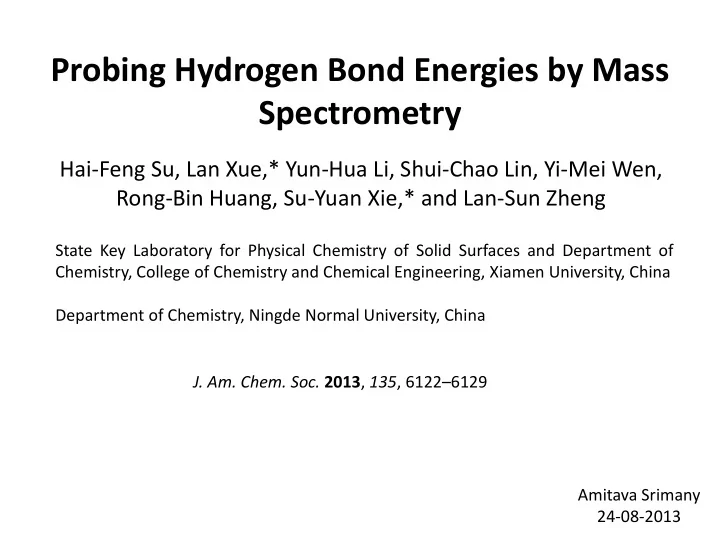

Probing Hydrogen Bond Energies by Mass Spectrometry Hai-Feng Su, Lan Xue,* Yun-Hua Li, Shui-Chao Lin, Yi-Mei Wen, Rong-Bin Huang, Su-Yuan Xie,* and Lan-Sun Zheng State Key Laboratory for Physical Chemistry of Solid Surfaces and Department of Chemistry, College of Chemistry and Chemical Engineering, Xiamen University, China Department of Chemistry, Ningde Normal University, China J. Am. Chem. Soc. 2013 , 135 , 6122–6129 Amitava Srimany 24-08-2013
INTRODUCTION Hydrogen bond is a class of attractive interaction ubiquitous in materials and prevalent in inorganic, organic, supramolecular, biological, medicinal, and pharmaceutical chemistry. Properties like catalyzed reactions, chelate cooperativity, mechanical properties, and glass transition are highly sensitive to the strength of the hydrogen bond. Most of the available methods for determination of the hydrogen bond, such as NMR and IR spectroscopy, are far from quantification regarding hydrogen bond energies. Historically, the shortening of distance between donor and acceptor determined by crystallographic data corresponds with the strength of hydrogen bond. The crystal packing is driven possibly by a combination of various intermolecular forces, e.g., hydrogen bond, halogen bond, π−π interaction, or others. It is hard to distinguish the hydrogen bond from the other intermolecular forces by means of crystallography itself. In this paper, DESI-MS have been used to probe the hydrogen bonds in the complexes of benzothiazoles and carboxylic acids.
RESULTS AND DISCUSSION N S NH 2 2-Aminobenzothiazole Hydrogen bond motifs in the cocrystals
Hydrogen bond lengths of compounds 1 −5 from crystallographic data
ESI MS data DESI MS data
Pristine crystals of complex 1 and complex 3 Setting closely, no contact or overlap DESI-MS Pristine crystals of complex 1 and complex 3 Setting overlap DESI-MS Recrystallization of complex 1 and complex 3 DESI-MS
Position of protonation 2A6MBT ESI-MS CH 3 OH solvent 2A6MBT ESI-MS CH 3 OD solvent 2A6MBT.aze DESI-MS CH 3 OH solvent 2A6MBT.aze DESI-MS CH 3 OD solvent
Possible paths for the dissociation of 2A6MBT
Mass spectrum of 2A4MBT.octa acquired in a CID collision energy Fragmentation rate = Fragment intensity/Total (parent + fragment) intensity
Fragmentation efficiency curves for complexes 1 −5
y = 2.754−0.007x Correlation between the length of O −H···N (Å) and the normalized collision energy (%) at 100% fragmentation rate
y = 48.9 −116.6x Correlation between the slope of the fragmentation efficiency curve and the average difference of the hydrogen bond between O −H···N and N−H···O (Å)
Fragmentation efficiency curves for complexes 6 −8
H-bond length data from MS and crystallography Complex O −H···N length O −H···N length N −H···O length N −H···O length (Å) from MS (Å) from (Å) from MS (Å) from crystallography crystallography 6: 2A6MOBT.mal 2.682 2.701(3) 2.963 2.833(3) 7: 2A6MOBT.pim 2.671 --- 2.934 --- 8: 2A6MOBT.seb 2.656 2.649(4) 2.965 3.057(5)
Hydrogen-bonded complex of 6 (top) and the corresponding hydrogen bond motifs in 1 −5 and 8
SUMMARY AND CONCLUSIONS In this work, a mass spectrometric method, based on DESI-MS with CID fragmentation, for probing the hydrogen bonds have been proposed. The strengths of the hydrogen bonds between the benzothiazoles and the carboxylic acids determined by X-ray crystallography are well correlated with the slope of the fragmentation efficiency curves and the collision energy of CID at a 100% fragmentation rate in the fragmentation efficiency curves of the corresponding mass spectra. Mass spectrometry is a complement of X-ray crystallography for probing hydrogen bonds because of some unavoidable additional forces in the crystal to influence the accurateness of crystallographic data.
FUTURE POSSIBILITIES This method can be just be extended towards other systems to probe H-bonds. MS can be used to probe metal complexes. For example, various metal-EDTA, metal- porphyrin complexes can be probed to find relative binding strength of metals with the ligand. With different degree of dissociation of complexes in the gas phase, different gas phase reactions can be initiated.
THANK YOU
Recommend
More recommend